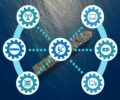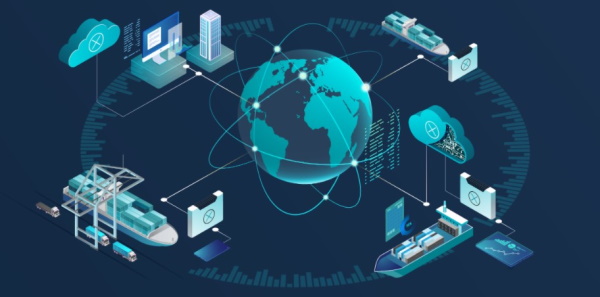 Over the past few years, the Internet of Things (IoT) has emerged as one of the most important technologies of the 21st century. Now that we can connect everyday objects – kitchen appliances, cars, thermostats, baby monitors – to the internet, seamless communication is possible between people, processes, and things. And this megatrend is increasingly moving into the industry, where the Industrial Internet of Things (IIoT) has enormous potential benefits to maritime operations.
Over the past few years, the Internet of Things (IoT) has emerged as one of the most important technologies of the 21st century. Now that we can connect everyday objects – kitchen appliances, cars, thermostats, baby monitors – to the internet, seamless communication is possible between people, processes, and things. And this megatrend is increasingly moving into the industry, where the Industrial Internet of Things (IIoT) has enormous potential benefits to maritime operations.
In fact, according to McKinsey, if businesses and policymakers get it right, linking the physical and digital worlds could generate up to $11 trillion a year in economic value by 2025. And what is most exciting for the maritime industry as a whole is that maritime infrastructure, vessels, and equipment are to a large extent already smart, meaning they are already filled with sensors and able to communicate information. The last piece of the puzzle is to simply make the connections.

Edge computing in the maritime industry
However, while the technology to connect maritime sensors and equipment exists, a key extra challenge has been how to handle the complexity of a large number of different connection interfaces and data protocols of onboard equipment and sensors. Due partly to this complexity, the industry at large has been somewhat behind the curve in IIoT adoption.
But now we are in a new era. Up-and-coming maritime technology providers are developing IoT devices that are capable of collecting vessel data from a far wider range of maritime data protocols, in addition to the ability to run apps locally. The result is something called “edge computing”. The benefits of edge computing is that apps that are available to the crew do not suffer from limited communication or latency issues offshore and that collected data can be stored and processed locally.
What this means for the noon report
Vessel operations and the global maritime supply chain are increasingly complex and interconnected. Efforts to optimize vessel performance, streamline processes, and optimize supply chains must therefore be supported by the ability to examine every process component and supply chain link in granular detail.
The noon report is the most used form for monitoring vessel operations and performance. But due in part to the complexity above, what started out as an innocent position report has slowly but steadily evolved into a monster – with various formats of noon reports being provided to not just ship owners and managers, but also charterers, sub-charterers, weather providers, ports and terminals, oil majors, commodity traders, agents, and more. Historically, all this data has been manually collected by the crew, and some noon reports have become so elaborate that it takes several hours to collate all the data required from different areas of the ship.
IIoT solutions built for the maritime industry are uniquely positioned to solve all this complexity. With these solutions, data directly from your engines, flowmeters, vessel management system, or navigation equipment can be drip-fed into your reporting. And depending on the solution you work with, it is possible to not only collect generic data points, but also interface with equipment or sensors that are unique performance indicators to your operation.
This means data that is more reliable, from a wider variety of sources, and in much higher resolution – a potential game-changer for operations, as independent research shows that there is a ten-fold improvement in uncertainty achieved using a continuous monitoring set relative to a noon report dataset (Ship Operational Efficiency: Performance Models and Uncertainty Analysis, Lucy Gemma Aldous 2015). The automated collection of data is also valuable in terms of drastically reducing the administrative workload for your crew, and minimizing the chance of human error.
Use your noon report data for more than just reporting
But just as important as collecting data is the ability to put it in the hands of people who can make use of it. Obvious ways that it can be accessed and used are in the apps running on the IoT edge device, in the cloud, or as an Excel export. But perhaps the most exciting way is through the unsung hero of our connected world – the API (Application Programming Interface). APIs are the engine that enable different pieces of software to exchange information.
With APIs that already exist today, maritime businesses are able to access performance and reporting data in a uniform way not just from individual vessels, but across their whole fleets. And they are able to share and use it in multiple ways – with their supply chains for on-the-fly efficiency and performance gains, for research, compliance, and more in their own tools, dashboards, and apps. APIs are not only an integration technology but a key strategic asset in the digital transformation of the maritime industry.
Leverage better data and rev your growth engine
With the right data integration and management platform, maritime businesses can finally leverage their data’s strategic value, improve operations, increase profits, and strengthen relationships with customers, partners, and suppliers. In manufacturing, it is already recognized that IIoT-powered analytics is no longer a “nice to have”. Companies that seize the opportunity presented by IIoT now, are going to develop strong competitive advantages in an oversupplied market that will help them power through 2025 – and maybe pick up some of that value predicted by McKinsey.
Source: Onboard, By Florus Wilming